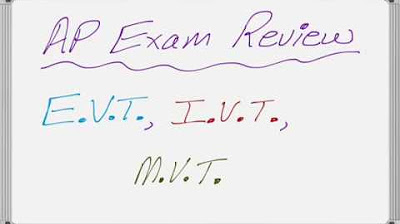Mean Value Theorem and Rolle's Theorem
TLDRThis educational video script introduces two fundamental theorems in calculus: the Mean Value Theorem (MVT) and Rolle's Theorem. The MVT asserts that for a continuous and differentiable function on a closed interval, there exists at least one point where the instantaneous rate of change equals the average rate of change. Rolle's Theorem is a special case of MVT, applicable when the function's values at the endpoints are equal, guaranteeing a point of zero derivative within the interval. The script elucidates these concepts with examples, including a practical scenario involving speed and distance, illustrating how the theorems can be applied to real-life situations.
Takeaways
- 📚 The Mean Value Theorem (MVT) is applicable when a function is continuous on a closed interval and differentiable on the open interval, implying there exists at least one point 'C' where the instantaneous rate of change equals the average rate of change.
- 📈 The geometric interpretation of MVT suggests that the secant line (average rate of change) is parallel to the tangent line (instantaneous rate of change) at some point 'C' between 'A' and 'B'.
- 🔍 An alternative expression of MVT is given by the equation F(B) - F(A) = f'(C) * (B - A), which can be used to find the exact point 'C' where the tangent line is parallel to the secant line.
- 🌟 A special case of MVT, known as Rolle's Theorem, states that if a function is continuous and differentiable on an interval and the function values at the endpoints are equal, there exists at least one point 'C' where the derivative is zero.
- 📉 Rolle's Theorem is sometimes referred to as the 'what goes up must come down' theorem, indicating that a function with equal endpoints must have a zero slope at some point within the interval.
- 🔢 The script uses an example of a polynomial function to demonstrate that if the function values at the endpoints are equal, the theorem guarantees a zero derivative at some point within the interval.
- 🚗 An example involving a car's speed is given to illustrate how the Mean Value Theorem can be applied to real-world scenarios, such as proving a driver was speeding at some point during a journey.
- 🤔 The script poses a thought-provoking question about how a police officer could prove a driver was going 65 miles per hour at two separate instances within a four-minute interval, using the principles of MVT.
- 📝 The script emphasizes the importance of understanding the conditions and implications of the Mean Value Theorem and Rolle's Theorem for both theoretical and practical applications.
- 👮♂️ The final example in the script highlights the potential legal implications of the theorems, showing how they can be used to enforce speed limits and issue speeding tickets.
- 🧐 The script encourages viewers to think critically about the theorems, questioning whether the scenarios presented are plausible or if they involve some form of trickery.
Q & A
What are the two theorems discussed in the script?
-The two theorems discussed in the script are the Mean Value Theorem (MVT) and Rolle's Theorem.
What are the conditions for the Mean Value Theorem to apply?
-For the Mean Value Theorem to apply, a function must be continuous on a closed interval from A to B and differentiable on the open interval from A to B.
What does the Mean Value Theorem state about the relationship between the average rate of change and the instantaneous rate of change?
-The Mean Value Theorem states that the average rate of change of a function over an interval is equal to the instantaneous rate of change at some point C within that interval.
What is the geometric interpretation of the Mean Value Theorem?
-Geometrically, the Mean Value Theorem implies that the secant line connecting two points on the curve is parallel to the tangent line at some point between those two points.
What is the special case of the Mean Value Theorem discussed in the script?
-The special case discussed is when the function values at the endpoints A and B are equal, which guarantees that there is at least one point C in the interval where the derivative (slope of the tangent line) is zero.
What is Rolle's Theorem sometimes referred to as by the speaker?
-Rolle's Theorem is sometimes referred to by the speaker as the 'what goes up must come down' theorem.
How does the speaker illustrate the application of Rolle's Theorem with an example?
-The speaker illustrates Rolle's Theorem with an example of a polynomial function that is continuous and differentiable, with equal y-values at the endpoints. The theorem is used to find a point where the derivative (slope) is zero.
What is the purpose of the Mean Value Theorem in the context of the car speeding example?
-In the car speeding example, the Mean Value Theorem is used to argue that if a car averages a certain speed over a time interval, there must have been at least one instant when the car's instantaneous speed was equal to the average speed.
What is the conclusion drawn from the application of the Mean Value Theorem in the car speeding scenario?
-The conclusion is that if the driver was averaging 75 miles per hour over a four-minute interval, there must have been at least one moment during that interval when the driver's speed was exactly 75 miles per hour.
What is the final question posed by the speaker regarding the possibility of being ticketed for driving at 65 miles per hour twice during the four-minute interval?
-The speaker asks whether it's possible for the patrolman to prove that the driver was going 65 miles per hour at two different times during the four-minute interval, despite the average speed being 75 miles per hour.
Outlines
📚 Introduction to Mean Value Theorem (MVT)
The video script begins with an introduction to the Mean Value Theorem (MVT), a fundamental concept in calculus. The theorem states that if a function is continuous on a closed interval and differentiable on the open interval, there exists at least one point where the derivative (instantaneous rate of change) equals the average rate of change between the endpoints. This is illustrated geometrically as the parallelism between the secant line (average rate) and the tangent line (instantaneous rate). The script also mentions a special case of the MVT, where if the function values at the endpoints are equal, the derivative must be zero at some point in the interval, which is humorously referred to as the 'what goes up must come down' theorem.
📈 Applying Rolle's Theorem with a Polynomial Example
The script moves on to discuss Rolle's Theorem, a special case of the MVT, which is used when the function values at the endpoints are equal. An example is provided where a polynomial function is shown to be continuous and differentiable, satisfying the conditions for Rolle's Theorem. The function is evaluated at the endpoints to confirm the equality of function values, leading to the conclusion that there must be a point where the derivative is zero. The script then demonstrates how to find this point by calculating the derivative and setting it equal to zero.
🚗 Real-World Application: Speeding Ticket Scenario
In the final part of the script, a real-world scenario is presented where a driver is accused of speeding based on the average speed calculated over a distance and time interval. The script explains how the Mean Value Theorem can be applied to prove that if the driver's average speed was 75 miles per hour, there must have been at least one moment during the interval where the instantaneous speed was also 75 miles per hour. This is used to justify the speeding ticket. The script concludes with a thought-provoking question about whether the police can issue two tickets for driving at 65 miles per hour, based on the same average speed calculation, challenging the viewer to consider the implications of the MVT in this context.
Mindmap
Keywords
💡Mean Value Theorem (MVT)
💡Differentiable
💡Continuity
💡Secant Line
💡Tangent Line
💡Derivative
💡Rolle's Theorem
💡Average Rate of Change
💡Instantaneous Rate of Change
💡Taylor Polynomials
💡Speeding Ticket
Highlights
Introduction to Mean Value Theorem (MVT) and its abbreviation.
Explanation of MVT conditions: continuous on a closed interval and differentiable on an open interval.
Clarification that differentiability implies continuity but not necessarily derivative at endpoints.
MVT states existence of a number C where the average rate of change equals the instantaneous rate of change.
Geometric interpretation of MVT relating secant and tangent line slopes.
Alternative formulation of MVT involving F(B) - F(a) = f'(C) * (B - a).
Special case of MVT when F(a) = F(B), implying f'(C) = 0.
Rolle's Theorem described as a 'what goes up must come down' theorem.
Application of Rolle's Theorem to find where the derivative equals zero.
Example of using MVT to find a point where the tangent line is parallel to a given secant line.
Real-world application of MVT in proving speeding with average speed over a time interval.
Historical use of MVT in writing speeding tickets on toll roads.
Complex scenario of being ticketed for driving 65 mph twice during a four-minute interval.
Challenge posed to the audience to consider the validity of the complex speeding ticket scenario.
Transcripts
Browse More Related Video

The MEAN Value Theorem is Actually Very Nice

AP Calculus Review Three Theorems You Must Know (EVT, IVT, MVT)

Calculus 1 Lecture 3.2: A BRIEF Discussion of Rolle's Theorem and Mean-Value Theorem.

Mean Value Theorem

Mean value theorem | Existence theorems | AP Calculus AB | Khan Academy

Using the Mean Value Theorem with a Table of Values
5.0 / 5 (0 votes)
Thanks for rating: